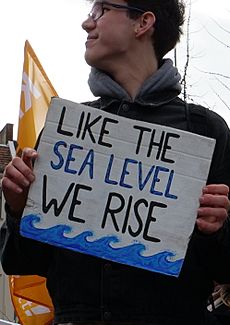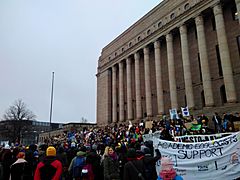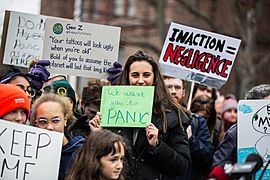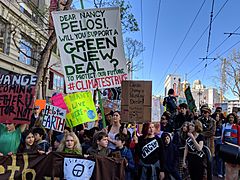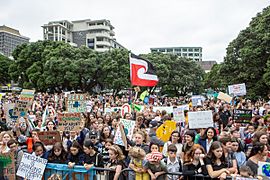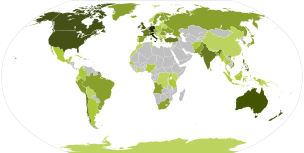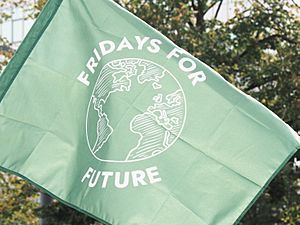School Strike for Climate facts for kids
Quick facts for kids School Strike for Climate |
||
|---|---|---|
| Fridays for Future Part of the climate movement |
||
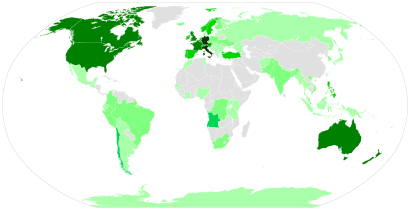
Maximum number of school strikers per country:
1000
1000+
10000+
100000+
1000000+
|
||
| Date | Since 20 August 2018, mostly on Fridays, sometimes on Thursdays, Saturdays or Sundays | |
| Location |
International
|
|
| Caused by | Political inaction against global warming | |
| Goals | Climate justice | |
| Methods | Student strike | |
| Status | Active | |
| Parties to the civil conflict | ||
|
||
| Number | ||
|
4 million (for 20 September 2019) 2 million (for 27 September 2019) |
||
| Website | ||
The School Strike for Climate, also known as Fridays for Future (FFF), is a worldwide movement. It involves school students who skip classes on Fridays. They do this to join protests. Their goal is to demand that political leaders take action. They want leaders to stop climate change and switch from fossil fuels to renewable energy.
This movement became well-known after a Swedish student named Greta Thunberg started protesting. In August 2018, she stood outside the Swedish parliament. Her sign said "School strike for climate."
On 15 March 2019, over one million students joined a global strike. They held 2,200 protests in 125 countries. Another big strike happened on 24 May 2019. Hundreds of thousands of students protested in 1,600 places across 150 countries.
In September 2019, the Global Week for Future took place. This included 4,500 strikes in over 150 countries. The protests on 20 September brought together about 4 million people. Many of them were schoolchildren.
Contents
How the Climate Strike Movement Started
Early Student Climate Protests
Students have protested about climate change before. In November 2006, the Australian Youth Climate Coalition formed. They organized climate actions for young people. In 2010, students in England walked out of school for climate change.
In November 2015, students asked others worldwide to skip school. This was on the first day of a big climate meeting in Paris. On 30 November, over 50,000 people joined a "Climate strike" in more than 100 countries. They asked for 100% clean energy and to keep fossil fuels in the ground.
Greta Thunberg's First Strike in 2018
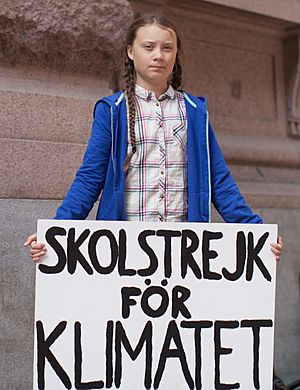

On 20 August 2018, Greta Thunberg, a Swedish climate activist, decided to stop going to school. She did this after heat waves and wildfires hit Sweden. She was inspired by students in Florida who organized the March for Our Lives.
Greta protested every school day outside the Swedish parliament. Her sign said "School strike for climate." She wanted the Swedish government to lower carbon emissions. On 7 September, she said she would strike every Friday. She would continue until Sweden followed the Paris Agreement. She created the phrase Fridays for Future. This idea spread worldwide and inspired many students.
Soon, school strikes for climate started in other countries. The first strike with more than one person happened in The Hague, outside the Dutch parliament. In Australia, thousands of students began striking on Fridays. This happened even though the Prime Minister asked for "more learning in schools and less activism." By December, strikes were happening in at least 270 cities. These included places like Australia, Germany, and the United Kingdom.
The Movement Grows in 2019
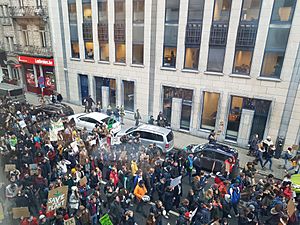
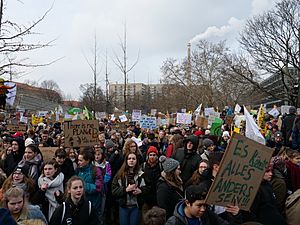
In 2019, strikes continued in many countries. New countries like Colombia, New Zealand, and Uganda joined. On 17 and 18 January 2019, over 45,000 students protested in Switzerland and Germany. They were upset about weak policies on global warming. Some students in Germany and the UK asked for the voting age to be lowered to 16. This would let them vote for leaders who care about climate.
In August 2019, Greta Thunberg sailed to New York City. She wanted to keep attention on the climate crisis. She joined school strikes in the U.S. on 20 September. Later, she spoke at the UN Climate Summit in New York City.
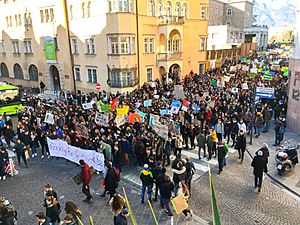
In Germany, local groups organized using online chat groups and social media. By February 2019, there were over 155 local groups. In the United States, groups coordinated using online tools and flyers. Many organizations helped, like Sunrise Movement and 350.org.
On 5 February 2019, a Belgian minister resigned. She had falsely claimed that the school strikes in Belgium were a "set-up."
In the United Kingdom, 224 experts signed a letter supporting the students. On 15 February, over 60 protests took place. About 15,000 students joined in the UK.
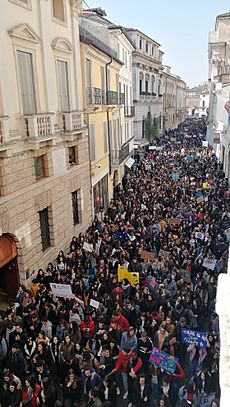
On 21 February 2019, the President of the European Commission, Jean-Claude Juncker, promised to spend a lot of money on climate change mitigation. He made this announcement next to Greta Thunberg. Media outlets said the school strike movement helped cause this decision.
On 5 March 2019, 700 German-speaking researchers supported the strikes. More than 26,800 scientists from Germany, Austria, and Switzerland signed this statement.
On 9 May 2019, student leaders met with European leaders. They gave them an open letter signed by over 16,000 climate strikers.
Global Climate Strike on 15 March 2019
On 15 March 2019, a huge series of school strikes happened. Students wanted adults to take responsibility for climate change. Over one million people protested in about 2,200 events. These took place in 125 countries.
On 1 March 2019, 150 students, including Greta Thunberg, wrote an open letter. It was published in The Guardian. They said:
We, the young, are deeply concerned about our future. [...] We are the voiceless future of humanity. We will no longer accept this injustice. [...] We finally need to treat the climate crisis as a crisis. It is the biggest threat in human history and we will not accept the world's decision-makers' inaction that threatens our entire civilisation. [...] Climate change is already happening. People did die, are dying and will die because of it, but we can and will stop this madness. [...] United we will rise until we see climate justice. We demand the world's decision-makers take responsibility and solve this crisis. You have failed us in the past. If you continue failing us in the future, we, the young people, will make change happen by ourselves. The youth of this world has started to move and we will not rest again.
In Scotland, some city councils allowed children to join the strikes. In Finland, schools sent out parent permission letters. In the city of Turku, the school board said children had a right to strike.
On the morning of 15 March, Greta Thunberg and other student leaders wrote an article in The Guardian. They explained why they were striking. They said, "Today's climate strike is the biggest lesson of all."
In Germany, over 300,000 students protested in 230 cities. Over 25,000 were in Berlin alone. In Italy, over 200,000 students protested. In Montreal, over 150,000 attended. Other cities included Paris, London, and Tokyo. Even in Antarctica, seven scientists held a supportive rally.
In Christchurch, New Zealand, the strike was cancelled for safety reasons. This was after a terrible event at two nearby mosques.
-
School Strike for Climate in front of the Parliament House, Helsinki, 15 March 2019
-
"Fridays for Future" 15 March Toronto
-
School strike in San Francisco on 15 March 2019
-
School strike in Cleveland on 15 March 2019
-
School strike for climate in Wellington on 15 March 2019
Second Global Climate Strike on 24 May 2019
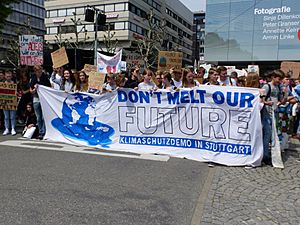
A second wave of global climate strikes started on 24 May 2019. Hundreds of thousands of students protested in over 1,600 towns. These were in at least 125 countries. Greta Thunberg said the strike happened during the 2019 European Parliament election. This was to influence the election. Polls showed climate change was a very important issue for voters.
International Climate Strike in Aachen on 21 June 2019
Fridays for Future Germany called for a large climate strike in Aachen on 21 June 2019. They invited people from 17 countries. Protesters gathered in different parts of the city. They walked or rode bikes through the streets. This blocked traffic for hours.
Organizers said 40,000 people protested. This made it the largest single FFF climate strike in a German city at that time. Many speakers and artists joined the event. Just before the strike, the city of Aachen declared a "climate emergency."
Global Week of Climate Action: September 2019
The September Global Week for Climate Action was a series of strikes. They happened from 20 to 27 September 2019. They were planned around the 2019 UN Climate Action Summit. Protests took place in 4,500 locations across 150 countries.
Organizers said over 4 million people joined the strikes on 20 September. This included 1.4 million in Germany and 300,000 in Australia. On 27 September, about 2 million people protested worldwide. Over one million were in Italy.
Fourth Global Climate Strike on 29 November 2019
On 29 November 2019, protests happened in 2,400 cities. These were in 157 countries. This was three days before a big UN Climate Change Conference. Organizers estimated 2 million people joined. About 630,000 were in Germany.
Recent Events (2020s)
Global Climate Strike on 25 September 2020
On 25 September 2020, another global climate strike took place. Strikes were planned in thousands of places.
Global Climate Strike on 19 March 2021
On 19 March 2021, a global climate strike saw protests in many places. Because of the COVID-19 pandemic, fewer people gathered in person.
Global Climate Strike on 24 September 2021
On 24 September 2021, strikes were planned in over 1,400 places. They happened in more than 90 countries. Large events took place in Europe, America, and Africa. Some of the biggest protests were in Germany. Greta Thunberg spoke to over 100,000 people in Berlin. She said, "No political party is doing enough."
Global Climate Strike on 25 March 2022
On 25 March 2022, a global climate strike took place.
Global Climate Strike on 23 September 2022
On 23 September 2022, a global climate strike took place. Over 30,000 people joined in Berlin.
Global Climate Strike on 3 March 2023
On 3 March 2023, a global climate strike took place. In Germany, strikes were planned in over 240 places. Over 18,000 people joined in Berlin. Fridays for Future Germany said over 220,000 people protested. They were against German climate policies, especially in transportation.
Digital Climate Strike Movement
The online climate strike movement is also called "digital strike." It was started by two Asian-American activists in April 2019. This way of striking helps people who cannot protest in person.
In March 2020, during the COVID-19 pandemic, Greta Thunberg encouraged people to strike from home. She suggested sitting at home with a sign and posting a picture online. This movement became very popular because of rules against large gatherings. Organizations like Greenpeace and Amnesty International noticed it.
The Fridays for Future Digital movement has worked on many campaigns. They want to raise awareness about climate justice. This includes teaching about climate change education in schools. They also work to protect indigenous climate activists.
Why Scientists Support Climate Strikes
The Science Behind Climate Change
Most scientists agree that human activities are causing Earth to warm. We release huge amounts of carbon dioxide and other gases. These gases trap heat, causing the greenhouse effect. In the past, this effect kept Earth from being covered in ice. But now, human activities are making it much stronger. This causes harmful global warming and climate change.
The only ways to remove carbon dioxide from the air are very slow. Geological processes take hundreds of thousands of years. Plants take carbon from the air, but this also takes time.
Many people believe that adults in power, like large companies and governments, are responsible for high carbon emissions. They are seen as doing too little to reduce them. In 2019, over 12,000 scientists said that "Young people's concerns are justified and supported by the best available science."
Scientists for Future
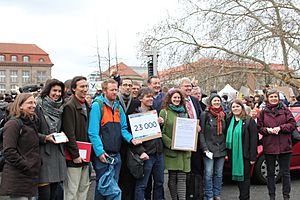
On 31 January 2019, over 3,400 Belgian scientists signed a letter. They supported the school strikes. The letter said, "On the basis of the facts supplied by climate science, the campaigners are right. That is why we, as scientists, support them." Scientists in the Netherlands and Finland also signed similar letters.
In Germany, Austria, and Switzerland, scientists formed Scientists for Future (S4F). They supported the facts presented by the movement. Over 26,000 German-speaking scientists signed their statement.
On 14 March 2019, the Club of Rome supported Greta Thunberg and the strikes. They asked governments to act and cut carbon emissions.
In April 2019, a letter was published in Science. It said the climate strikers' concerns are "justified and supported by the best available science." Over 3,000 scientists worldwide signed this letter.
In June 2019, 1,000 healthcare workers called for action. They said government policies on the environment were "woefully inadequate." They supported the school strike movement.
How Others Reacted to the Strikes
Adults in power have both praised and criticized the strikes. Some politicians called the strikes "truancy" (skipping school without permission). Some students were punished for striking. The UK Prime Minister at the time, Theresa May, said the strikes wasted lesson time. However, other UK political leaders supported the strikes.
Australia's Prime Minister, Scott Morrison, asked for "more learning and less activism." He said students should protest after school or on weekends. In New Zealand, some school principals threatened to mark students as truant.
On 15 March 2019, the UN Secretary-General António Guterres supported the strikers. He said, "My generation has failed to respond properly to the dramatic challenge of climate change. This is deeply felt by young people. No wonder they are angry." He invited world leaders to a UN meeting to make plans for climate action.
Many parents have also supported the children's climate strikes. Organizations like "Our Kids' Climate" encourage parents to join. They suggest parents bring signs that show their concern.
The term "climate strike" was named Collins Dictionary's 2019 word of the year. Its use increased a hundredfold that year.
Awards and Recognition
On 7 June 2019, Fridays for Future and Greta Thunberg received the Amnesty International's Ambassador of Conscience Award. The Secretary General, Kumi Naidoo, said:
We are humbled and inspired by the determination with which youth activists across the world are challenging us all to confront the realities of the climate crisis. Every young person taking part in Fridays for Future embodies what it means to act on your conscience. They remind us that we are more powerful than we know and that we all have a role to play in protecting human rights against climate catastrophe.
|
- Climate justice
- Earth Strike
- Individual action on climate change
- List of school climate strikes
- Youth activism
See also
 In Spanish: Fridays For Future para niños
In Spanish: Fridays For Future para niños


